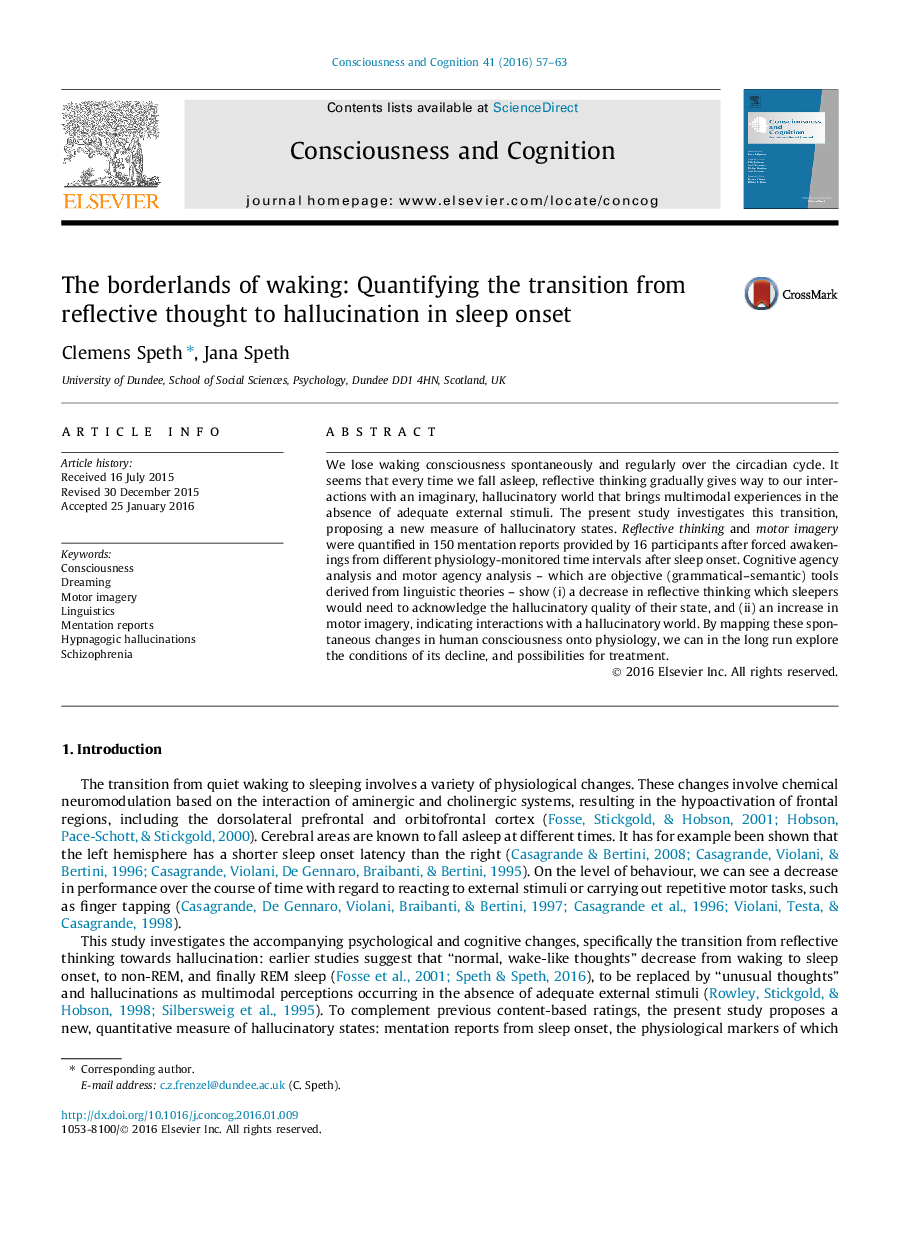| کد مقاله | کد نشریه | سال انتشار | مقاله انگلیسی | نسخه تمام متن |
|---|---|---|---|---|
| 7288656 | 1474170 | 2016 | 7 صفحه PDF | دانلود رایگان |
عنوان انگلیسی مقاله ISI
The borderlands of waking: Quantifying the transition from reflective thought to hallucination in sleep onset
ترجمه فارسی عنوان
مرزهای بیداری: تعیین میزان انتقال از تفکر بازتابنده به توهم در شروع خواب
دانلود مقاله + سفارش ترجمه
دانلود مقاله ISI انگلیسی
رایگان برای ایرانیان
کلمات کلیدی
ترجمه چکیده
ما هوشیاری بیدار شدن را به طور خود به خود و به طور مرتب در طول چرخه روزانه از دست می دهیم. به نظر می رسد که هر بار که ما به خواب می رویم، تفکر بازتابنده به تدریج به تعاملات ما با یک جهان خیالی، هذیانی تبدیل می شود که تجربیات متقابل را در غیاب محرک های بیرونی کافی به ارمغان می آورد. در این مطالعه، این تحقیق با هدف تعیین مقیاس جدیدی از اختلالات هذلولی انجام شده است. تفکر انعکاسی و تصاویر حرکتی در 150 گزارش تحرک ارائه شده توسط 16 شرکت کنندگان پس از بیداری اجباری از فواصل زمانی مختلف تحت فیزیولوژی پس از شروع خواب محاسبه شد. تجزیه و تحلیل آژانس های شناختی و تجزیه و تحلیل آژانس های حرکتی - که ابزار (گرامری و معنایی) از نظریه های زبان شناختی هستند، نشان می دهد (من) کاهش در تفکر بازتابنده که ملایان نیاز به تایید کیفیت توهم دولت خود، و (2) افزایش در تصاویر حرکتی، نشان دهنده تعاملات با جهان توهم است. با ترسیم این تغییرات خودبهخودی در آگاهی بشری به فیزیولوژی، می توانیم درازمدت شرایط زوال آن و امکانات درمان را بررسی کنیم.
موضوعات مرتبط
علوم زیستی و بیوفناوری
علم عصب شناسی
علوم اعصاب شناختی
چکیده انگلیسی
We lose waking consciousness spontaneously and regularly over the circadian cycle. It seems that every time we fall asleep, reflective thinking gradually gives way to our interactions with an imaginary, hallucinatory world that brings multimodal experiences in the absence of adequate external stimuli. The present study investigates this transition, proposing a new measure of hallucinatory states. Reflective thinking and motor imagery were quantified in 150 mentation reports provided by 16 participants after forced awakenings from different physiology-monitored time intervals after sleep onset. Cognitive agency analysis and motor agency analysis - which are objective (grammatical-semantic) tools derived from linguistic theories - show (i) a decrease in reflective thinking which sleepers would need to acknowledge the hallucinatory quality of their state, and (ii) an increase in motor imagery, indicating interactions with a hallucinatory world. By mapping these spontaneous changes in human consciousness onto physiology, we can in the long run explore the conditions of its decline, and possibilities for treatment.
ناشر
Database: Elsevier - ScienceDirect (ساینس دایرکت)
Journal: Consciousness and Cognition - Volume 41, April 2016, Pages 57-63
Journal: Consciousness and Cognition - Volume 41, April 2016, Pages 57-63
نویسندگان
Clemens Speth, Jana Speth,
